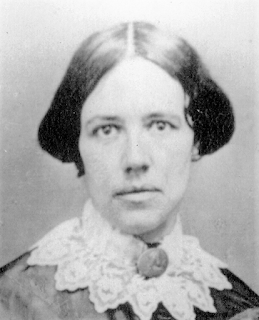Well, who was she?
Well, for one, she is touted for being one of the first astronomers in the United States.
She was the third of ten children, and belonged to a Quaker family--now, this is important, because this faith had an unusual (for the time) view of women. For this group, women could actually speak in the church service, and perhaps offer their interpretations of the scripture. From this background, a daughter could theoretically gain an education far ahead of other women who belonged to more traditional families.
Her education veered towards the scientific, because her father was also an astronomer. She also was more formally educated at a nearby school, where she specialized in both math and science. She was also a distant cousin to Benjamin Franklin! Now, while it was not exactly an honor to be vaguely related to a man who couldn't keep his dick in his pants, it is obvious that scientific curiosity does sometimes run in families.
As early as age 12, Mitchell began working with her father. It was at this age that she was able to aid her father in working out the precise moment of an annular eclipse. OK. What? The definittion of this celestial event is
An annular solar eclipse happens when the Moon passes between the Sun and Earth, but when it is at or near its farthest point from Earth. Because the Moon is farther away from Earth, it appears smaller than the Sun and does not completely cover the Sun. As a result, the Moon appears as a dark disk on top of a larger, bright disk, creating what looks like a ring around the Moon.
Jesus. At 12 I was still playing with my Chrissie Doll. You'll not know of it if you didn't grow up in the 70s, but it had this hair that grew long and short by pulling it out of the dolls' head....
But, I digress.
At 18, she left school to become a teacher of girls in both of these subjects. In 1836, she went to work in the library of the Nantucket Athenaeum--a private institution that lent books, until it was officially made public at the turn of the century. Mitchell worked also worked as a teacher in math and science, at various schools for girls in Nantucket. Later, she would open a school, where they accepted students of color: one of the first in our segregated country to do so.
This was an unusual occupation for a woman at this time, for many were subjected to a system known as 'ornamental education,' where a young woman was basically schooled in the more decorative arts--dancing, music, limited history and languages. This was an education to prepare women to become the ideal wife of the so-called 'holy home.' I know, I know. We're thinking Betty Crocker, or her modern day equivalent, Martha Stewart.
In the nineteenth century, any young woman, belonging to the upper or middle class was expected to strive for marriage and family. There were few, if any, avenues left open to her. There were some mavericks, though: Susan B. Anthony and Elizabeth Cady Stanton (but everyone already knows these two). I pick them only to serve as examples of women from a traditional background, who broke the mold to work for women's equality. But not all women were activists, and they chose to pursue private goals. However, a by-product of such actions can sometimes lead to notoriety, which provides necessary examples to other daughters of such a sexually oppressive time.
It was in 1836, and Maria was working with her father, in his small observatory, that she made a discovery: a comet that has a rough trajectory around the sun. It was initially 'discovered' by an Italian named Francesco de Vico, but later Mitchell was credited with its' discovery: her finding occurred two days earlier than his!
Technically, the comet is referred to by astronomers as "C/1847 T1". Here is a picture:
She made this discovery using a 2 inch telescope. No, seriously!
this is one of her later instruments. But, still, wow.
On the heels of this discovery, Mitchell was elected to the AAAS--Amercian Association for the Advancement of Science, as well as the American Philosophical Society. Obviously, these were remarkable accomplishments for any woman of the time.
Mitchell eventually made it to Europe, where she 'confabbed' with prominent astronomers. Returning, she continued to work at astronomy, eventually becoming a full professor at Vassar College. Her later accomplishments were as impressive as those of her youth--among other things, she pioneered an effort to track the orbit of Venus, and began preliminary exploration into planetary photography.
Well, what about women's rights? Mitchell certainly supported them, but it must be remembered that the suffrage movement was still in its infancy. I would say that on balance, she worked within existing systems towards opening up opportunities for women in the physical sciences.




Comments
Post a Comment